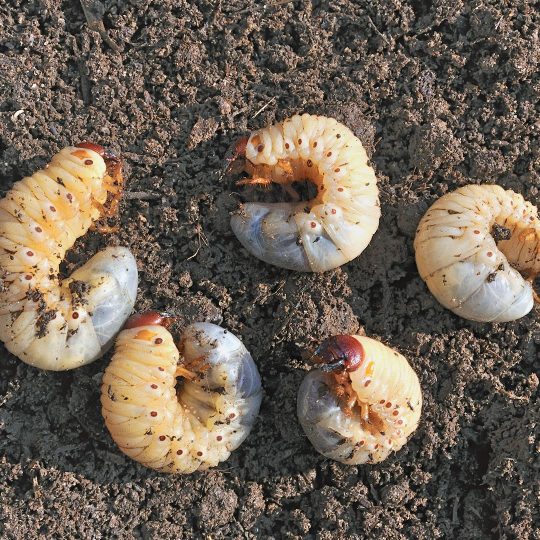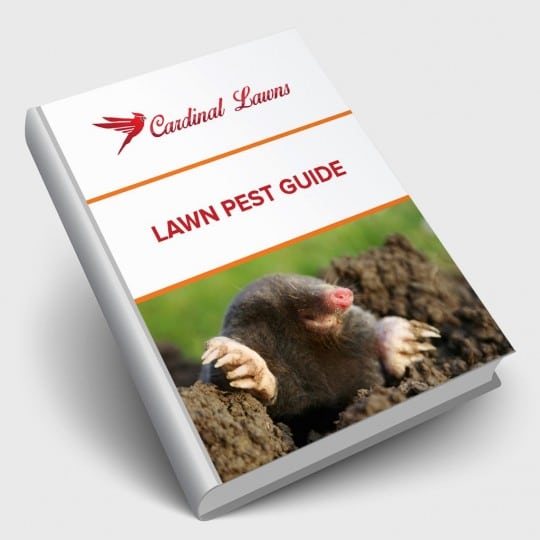What Attracts Grubs to your Yard?
And How to Repel Them
Posted
August 8, 2024

If you’ve seen Japanese beetles around your yard and eating your plants this summer, chances are they started as grubs in your lawn. Learn what attracts grubs to your yard and how to repel them to save your grass and garden from damage.
What Attracts Grubs to Your Yard?
Grubs are the larvae of various beetles, such as Japanese beetles, June bugs, and European chafers. Each of these pests can wreak havoc on lawns and gardens—turning grass brown and skeletonizing leaves. But when you understand what attracts these pests to your yard, you can work to repel them in order to help maintain a healthy, vibrant lawn. Here’s what grubs are looking for:
- Moderate temperatures. Grub populations tend to increase during a mild summer into fall.
- Moist soil. Whether you over-water your lawn or have poor drainage, excess moisture creates an ideal habitat for grubs.
- Thatch. Beetles like to hide and lay their eggs in thick layers of grass rich in organic material so there’s plenty of food for the larvae once they hatch.
While you can’t control the temperature, you can help eliminate excess moisture and thatch from your lawn to prevent grubs and beetles.
Grub Prevention
One of the best ways to prevent grub and beetle damage in your yard is to make the area less desirable for these pests. Now that you know what they like, you can work to correct some of these issues.
- Avoid over-watering your lawn. Watering deeply and infrequently allows the water to reach the roots and strengthen your grass. Let the soil dry out between watering to decrease the moisture grubs love.
- Mow at the right height. Cutting grass too short can stress the lawn, making it more susceptible to grub damage.
- Dethatch. Remove excess layers of dead grass to eliminate a grub habitat and improve water penetration.
- Aerate. Help improve drainage issues throughout the soil.
Not only will maintaining a healthy lawn give you a yard to be proud of, but it will also give you less pests to deal with.
Signs of a Grub Infestation
If you don’t properly maintain your lawn, there’s more of a chance grubs and other pests will move in. Here’s how to tell if you have a grub problem.
- Irregular patches of brown, dying grass can be easily pulled up like a carpet.
- Signs of wildlife—such as raccoons, skunks, and birds—digging up your lawn searching for grubs.
- Walking on grub-damaged grass feels spongy since the roots have been eaten away.
Once you start to see more signs of grubs, it’s time to take action before they destroy your lawn this season or show up as beetles next summer. That’s right. Grubs can overwinter deep beneath the soil and reemerge next year.
How to Repel Grubs
Strong, healthy lawns can naturally resist some grub damage. However, grubs flock to lawns with robust grass roots, so there’s still a chance you need to follow a few grub treatment options. If you regularly check for signs of grub activity—especially in the late summer and early fall—you have a better chance at effective control.
- Preventative products. There are certain insecticides formulated to target eggs and larvae. These should be applied in the late spring to early summer before any eggs hatch.
- Control products. Once you notice grubs are actively feeding, it’s time to apply another insecticide in the late summer to early fall for damage control.
Be sure to use the right product at the right time for more effective results. It may be necessary to combine methods for a more comprehensive approach to managing grubs. Keep monitoring the situation and maintaining your lawn to help prevent severe infestations. For help with severe cases, contact the lawn care specialists at Cardinal Lawns. We already understand what attracts grubs to your yard and have a range of control methods we can implement to help you protect your lawn from pests.

Download Your FREE Lawn Pest Guide
Pests become most prevalent during the heat and humidity of summer. Take some time to learn about the signs of infestations before any damage can be caused to your landscape. This handy guide will teach you how to spot common lawn pests and how to keep them from causing harm to you and your property.